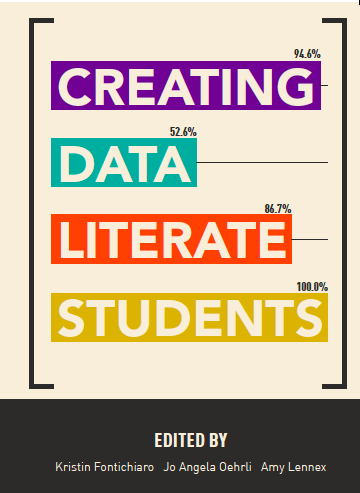“[A] great resource!”
– 2017 conference attendee
How to access:
- FREE: Download PDFs by chapter
- FREE: Access a machine-readable version for those with disabilities or who prefer titles to be read aloud by the computer
- PURCHASE: Click here to purchase a print copy from Amazon.
- PURCHASE: Kindle eBook version coming soon!
Your high school students are swimming in data. From BuzzFeed quizzes to charts and tables in textbooks, from statistics flouted by politicians to figuring out what student loans really mean, data plays a big role in how they navigate the world.
Data — both raw and displayed in visualizations — can clarify or confuse, confirm or deny, persuade or deter. Students often learn that numbers are objective, though data in the real world is rarely so. In fact, visualized data — even from authoritative sources — can sometimes be anything but objective.
There is growing recognition among librarians that students are either making poor decisions about the quality of statistics, data, and related visualizations or that they lack the ability to comprehend these resources altogether. How do students interpret statistics, data, and related visualizations and issues “in the wild” when conducting research
Librarians and classroom educators need to be as fluent with quantitative data as they are with text in order to support high schoolers as they engage with data in formal and informal settings. We asked contributors to this volume — experts in high school curriculum, information literacy and/or data literacy — to explore the intersections between data and curriculum and identify high-impact strategies for demystifying data for educators and students alike.
Creating Data Literate Students provides high school librarians and educators with foundational domain knowledge to teach a new subset of information literacy skills — data and statistical literacy, including:
- statistics and data comprehension
- data as argument
- data visualization
Working in concert, these concepts can help librarians and educators make better sense of real-world data concerns and have the confidence and content knowledge to share those skills with the high schoolers they serve.
Introduction
Kristin Fontichiaro, Jo Angela Oehrli, Amy Lennex
Chapter 1: Introduction to Statistical Literacy
Lynette Hoelter
Chapter 2: Statistical Storytelling: The Language of Data
Tasha Bergson-Michelson
Chapter 3: Using Data in the Research Process
Jole Seroff
Chapter 4: Real world data fluency: How to use raw data
Wendy Steadman Stephens
Chapter 5: Manipulating data in spreadsheets
Martha Stuit
Chapter 6: Making Sense of Data Visualization
Justin Joque
Chapter 7: Data presentation: Showcasing your data with charts and graphs
Tierney Steelberg
Chapter 8: Deconstructing data visualizations: What every teen should know
Susan Smith
Chapter 9: Designing your infographic: Getting to design
Connie Williams
Chapter 10: Using data visualizations in the content area
Jennifer Colby
Chapter 11: Teaching Data Contexts: An Instructional Lens
Debbie Abilock
Chapter 12: Diving Lessons: Taking the Data Literacy Plunge Through Action Research
Susan D. Ballard
